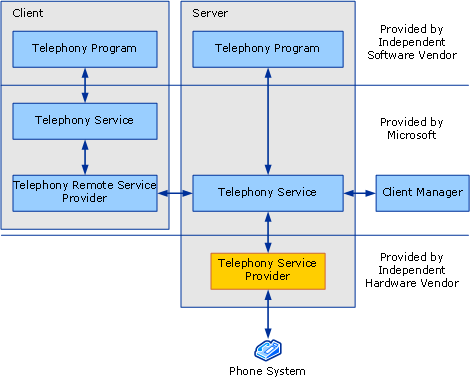The following telephony service providers are supplied with this version of the Windows operating system.
HID Phone Telephony Service Provider
The Human Interface Device (HID) Phone telephony service provider allows users of TAPI-based programs to make and receive telephone calls by using universal serial bus (USB) telephone handsets connected to their computers. This service provider is installed with Windows Server® 2008, and it requires no configuration.
NDIS Proxy Telephony Service Provider
The Network Driver Interface Specification (NDIS) Proxy telephony service provider enables the Telephony service to control NDIS 5 devices. Routing and Remote Access uses this telephony service provider to set up network connections across NDIS WAN devices. This service provider is installed with the Windows Vista, Windows Server 2008, Windows XP, and Windows Server 2003 operating systems. To map addresses for the different types of calls received by the NDIS Proxy telephony service provider on the local computer, see Configure a Telephony Service Provider on a Telephony Client.
TAPI Kernel-Mode Service Provider
The TAPI Kernel-Mode service provider allows TAPI to control NDIS 4 devices. Network Connections uses this telephony service provider to set up network connections across NDIS WAN devices. This service provider is installed with the Windows Vista, Windows Server 2008, Windows XP, and Windows Server 2003 operating systems, and it requires no configuration.
Unimodem 5 Service Provider
The universal modem driver (Unimodem) provides services for data, fax, and voice modems so that users and program developers do not have to learn or maintain modem AT commands to dial, answer, and configure modems. Unimodem performs these tasks by using files that specify the AT command sets and expected responses for modems. These files usually have an .inf extension. Unimodem supports both data and voice, so that a modem can be used for data and fax functions, as a speaker phone, as an answering machine, and so on. This service provider is installed with the Windows Vista, Windows Server 2008, Windows XP, and Windows Server 2003 operating systems.
Windows Remote Service Provider
The Windows Remote Service Provider enables a client computer to access and control remote telephony devices connected to a server computer, such as telephones and phone lines. The remote service provider makes the client-to-server link transparent to programs.

The Windows Remote Service Provider resides on the client computer, where it appears as a telephony service provider. When a program makes a telephony request, the service provider interprets the request and sends it across the computer network to the Telephony service running on the server. The program then uses the telephony service provider for the telephone device installed on the server. By using this solution, clients can share a telephony resource over the network.
The Windows Remote Service Provider is installed with the Windows Vista, Windows Server 2008, Windows XP, and Windows Server 2003 operating systems.
Additional considerations
-
The H.323 and IP Multicast providers that were included with Windows XP and Windows Server 2003 are no longer available.
-
For information about configuring telephony service providers, see Manage Telephony Service Providers on a Server.